2008 VOLKSWAGEN GOLF weight
[x] Cancel search: weightPage 9 of 444
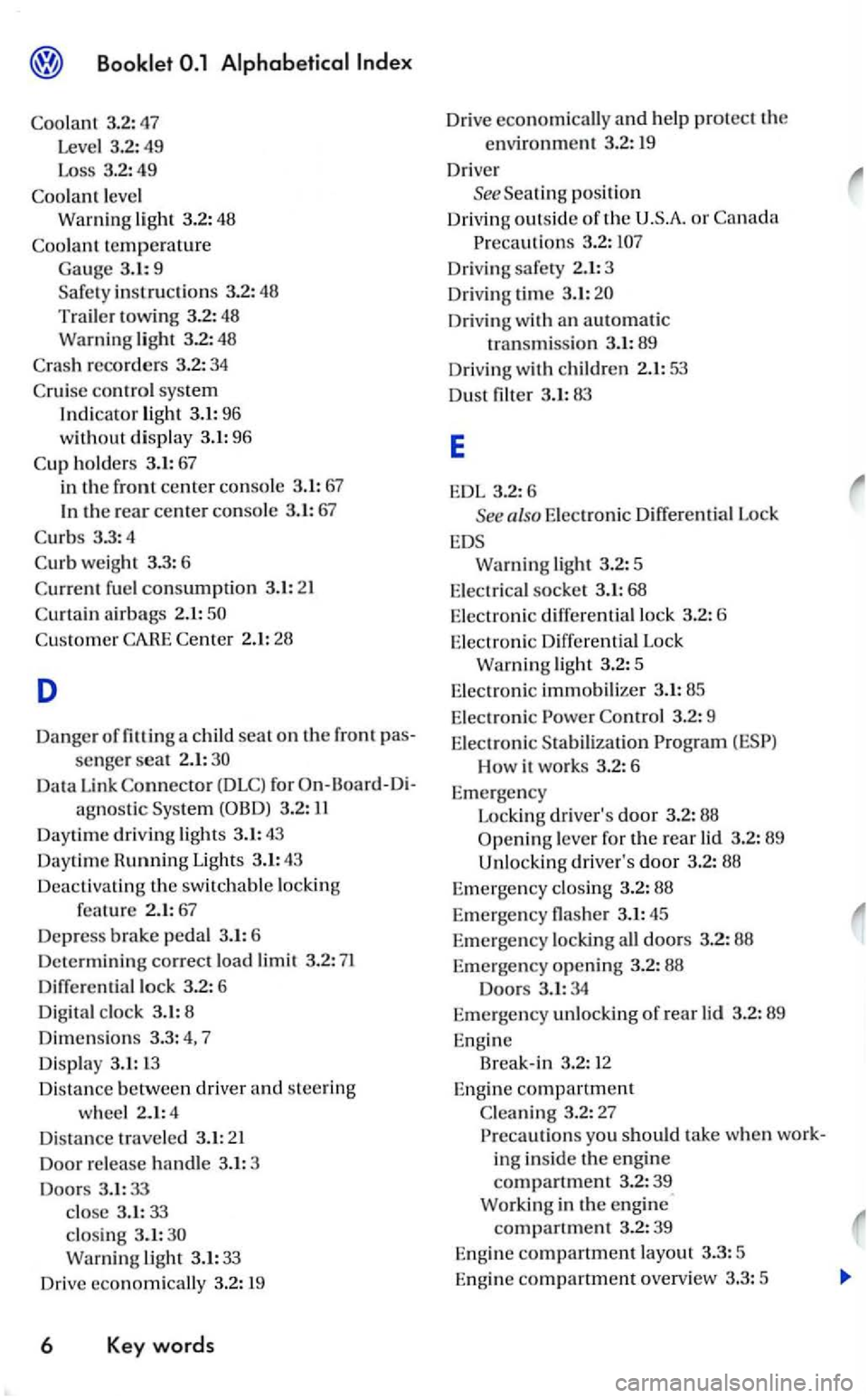
Coolant 3.2: 47
Level 3.2:
49
Loss 3.2:49
Coolant leve l
Warning light 3.2: 48
Coolant temperature
Gauge 3.1:9 Safe ty instru ctions 3.2:48
Trail er towing 3.2: 48
Warning light 3.2 : 4 8
C
ras h recorders 3.2: 34
C rui
se control system
Indicator light 3.1:96
without display 3.1: 96
C up ho ld ers 3.
1: 67
in the front center consol e 3 .1: 67
the rear center console 3.1:67
Curbs 3.3:4
Curb weight 3.3 : 6
C
urrent f u el con sumptio n 3.1:21
C
urtain airbags 2.1:
Custome r Center 2.1: 28
D
Danger of fittin g a child seat on the front pas
senger seat 2.1:
Daytime dri ving lights 3.1:4 3
Daytime Hunning Light s 3.1: 43
D
eactiv ating the switchabl e lockin g
2.1: 67
Depress brake ped al 3.1: 6
Determining correct load l im it 3.2: 71
Diff
erential lock 6
Digit al cl
ock 3.1:8
Dimensio n s 3.3: 4, 7
Disp la y 3.1: 1 3
D is t
ance b etween driver and steerin g
w h
eel 2.1:4
D is ta n
ce travele d 3.1: 21
Door re lease h andle 3.1: 3
Doors 3.1:33
close 3.1: 33 closing 3.1: Warning li gh t 3.1: 33
Drive economically 3.2: 19
6 Key words
Drive economic all y and he lp protect the
environment 3.2: 19
Driv er See Seating position
Drivin g outside of the
Driving safety 2.1: 3
Driving lime 3
.1:
E
EDL 3.2:6
See also Electronic Differ ential Lock
Warning light 3.2:5
Electrical socket 3.1: 68
E
lectronic diff ere nti al lock 3.2: 6
Electroni c Differential Lock
Warning light 3.2: 5
Ele c
tronic immobilizer 3.1:85
E l
ectronic Co ntrol 3.2: 9
E l
ectronic Stabilization
How it works 3.2: 6
Eme rge ncy
L
ockin g driver's door 3.2: 88
Opening l eve r for the rear lid 3.2: 89
Unl ocki ng
driver's door 3.2: 88
Em ergency closing 3.2: 88
E m er
gency nasher 3.1: 45
E m
ergency locki ng all doors 3.2: 88
Emergency ope nin g 3.2: 88 Doors 3.1: 34
Emer gency
unlocking of rear lid 3.2: 89
E ng
ine Break-in 3.2: 12
Eng in e compartment
Cleaning 3.2 :27 you should take when work
i
ng in sid e the e ngin e
compartment 3.2:39 Work ing in the engine
compartment 3.2: 39
E n g in e
compartment la yout 3.3 : 5
E n
gine compartment overview 3.3: 5
Page 12 of 444
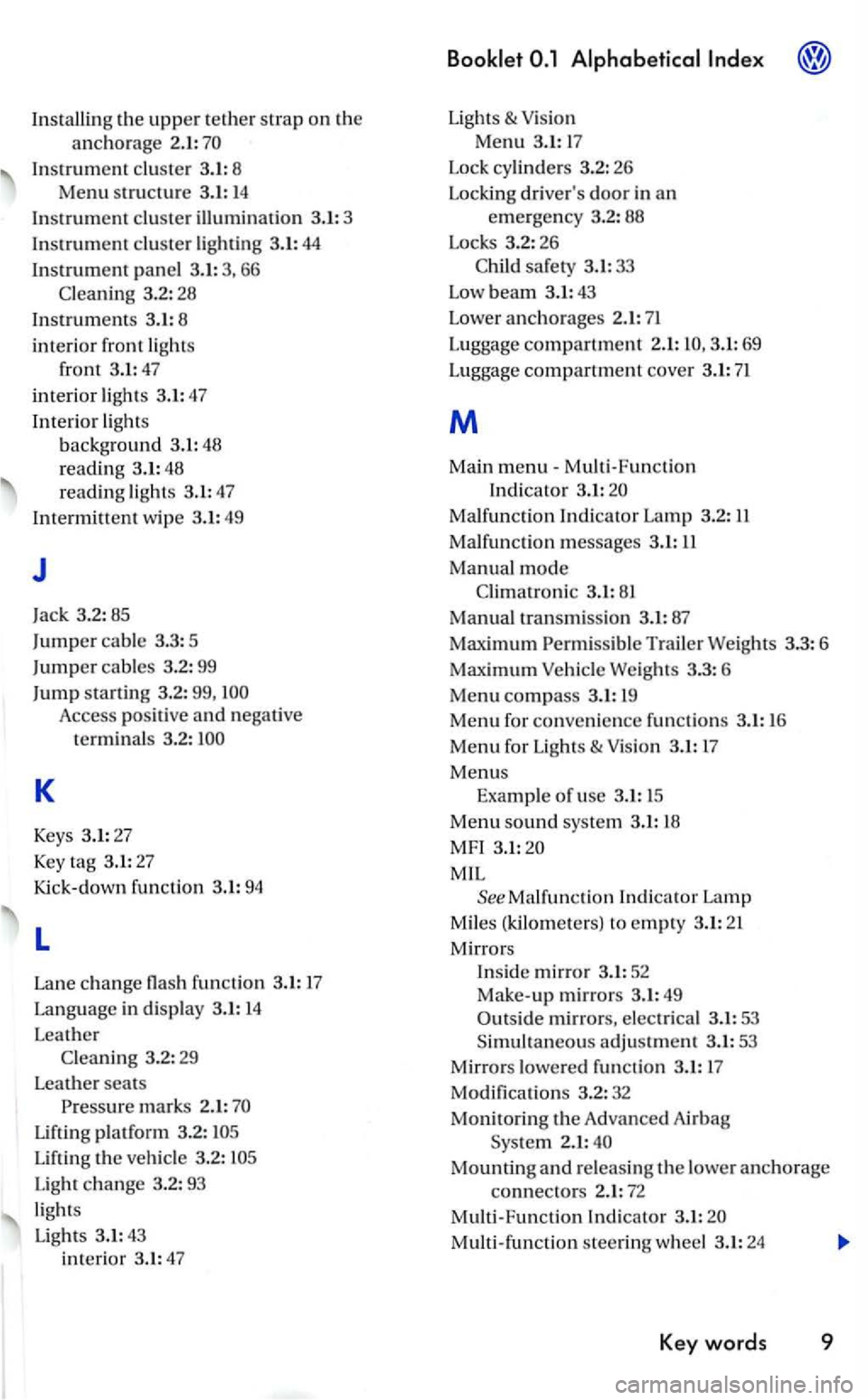
Installin g the upper te ther strap on the
anchorage 2.1:
Instrument cluster 3.1: 8
Menu structure 3. 1: 14
Instrument cluster illumination 3.1: 3
Instrument cluster lighting 3.1: 44
Instrument panel 3. 1:
K
Access positive an d negative
t
erminal s 3.2:
Light change 3.2: 93
lights
Lights 3.1: 43 interior 3.1:47
Lights & V is ion
Menu 3.1:17
Lock 3 .2: 26
Locking driver's door in an e m erge ncy 3.2: 88
Locks 3.2: 26
Chi .ld safety 3.1: 33
Low beam 3.1: 43
Lower anchorages 2.1: 71
Luggage compartment 2.1: 3.1: 69
Luggage compartment cover 3.1:71
M
Main menu -Mu lt i-Function
In dicator 3.1:
Malfunct ion Indicator Lamp 3.2:
Vehicle Weights 3.3: 6
Menu compass 3.1: 19
Menu for convenience functions 3.1: 16
Menu for Lights & Vision 3.1: 17
Menus Examp le of use 3.1:
Menu sound system 3.1:
MFI 3.1:20
M IL
m irrors, electrical 3.1:53 Simultaneous adjustment 3.1:53
Mirrors lowered function 3.1: 17
Modifications 3.2: 32
Monitoring th e Advanced Air bag System 2.1:
Key words 9
Page 17 of 444
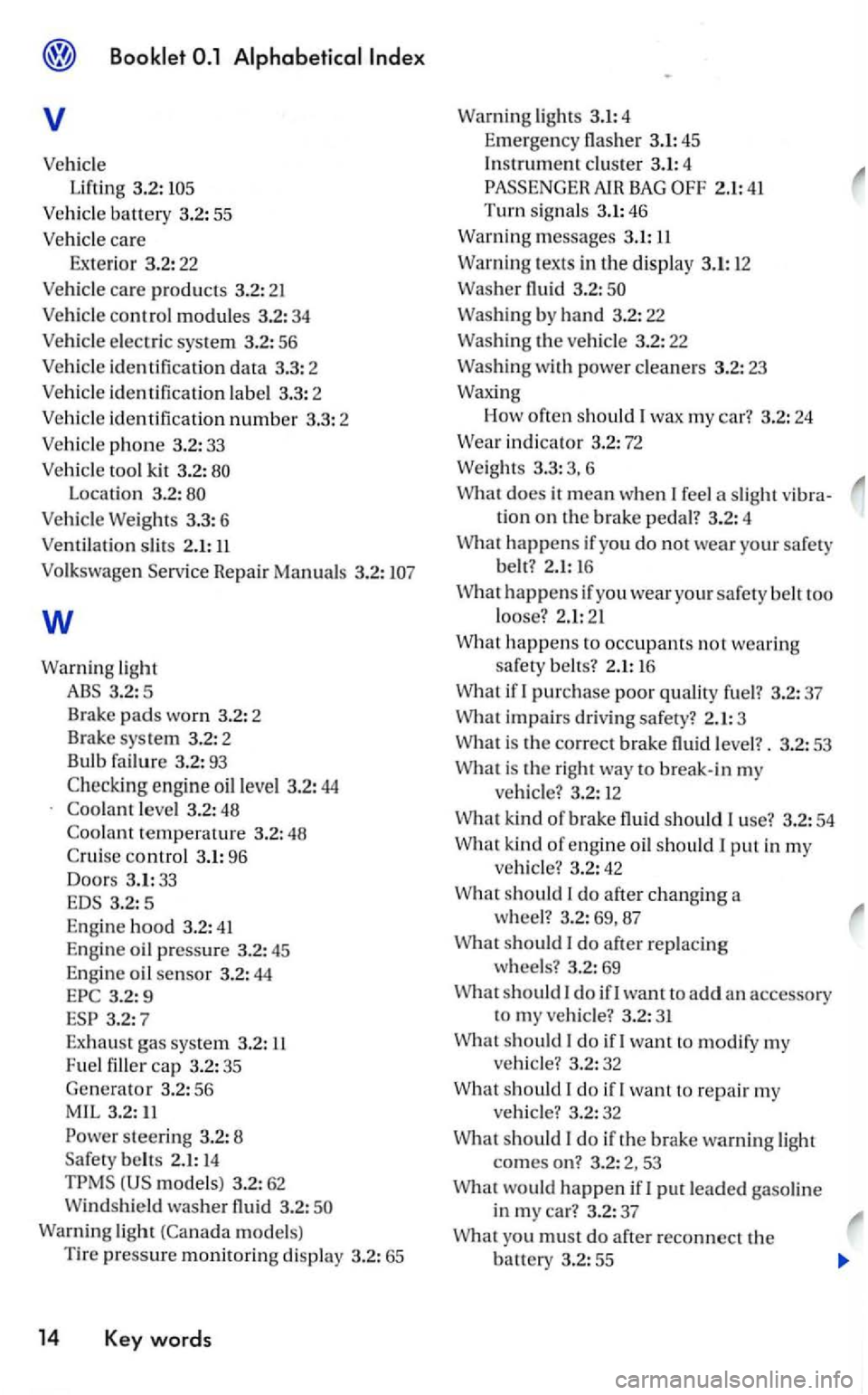
Booklet
v
Vehicle Lifting 3.2:
Location 3.2:
Vehicle Weights 3.3: 6
Ventil atio n slit s 2.1:
Volk s wagen Servic e Repair Manuals 3.2 :
w
Warn ing light
3.2: 5
Brake
pads worn 3.2: 2
Brake system 3.2: 2
Bulb failure 3.2:
93
3.2:5
Eng ine hood 3.2:41
Engine oil pressure 3.2: 45
E n
gin e oil se nsor 3.2:44 3.2:9
3.2:7 Exhaust gas syste m 3.2:
Fuel fille r cap 3.2 : 3 5
Gen erat or 3.2: 56 MIL
steering 3.2: 8
Safe ty belts 2.1: 14
mode ls) 3.2 : 62
Wind shi eld washer fluid 3.2 :
Warning light (Ca nada models)
Tire pressure m onitorin g di spla y 3.2: 65
14 Key words
Warn ing light s 3.1: 4
Emergency
flasher 3.1: 45
I n strume nt clus te r 3.1: 4
Washi ng by hand 3.2:22
Wash in g th e ve hicle 3.2: 22
Washin g with power cleaners 3.2: 23
Waxing How often s
hould I wax my car? 3.2: 24
Wear indicator 3.2:
72
Weights 3.3: 3.
What does it mean when I feel a slight vi bra-tion o n the brake pedal ? 3.2: 4
W h
at happens if yo u do not wear your safe ty
b elt ? 2.1: 16
happe n s if you wear yo ur safe ty belt too
l oose?
2.1: 21
happe n s to occupants not wearin g
safe ty belt s? 2.1:
if I purchase poor quality fuel? 3.2: 37
is the correct brake fluid leve l?. 3.2: 53
What is the r ight way to break-in my
ve hicl
e? 3.2: 12
kind of brake fluid should I u se? 3.2: 54
What kind of engine oil should 1 put in my
ve hicle ? 3.2: 42
What should I d o a fter changing a
w heel? 3.2: 69, 87
should I do after re pla cing
wheels? 3.2:
should I do if! want t o add an acces sory
t o my vehic le? 3.2: 31
sh o uld I do if I want to modify m y
ve hicle? 3.2: 32
should I do if I want to re p air my
ve hicle? 3.2: 32
What sh o uld I
do if the brake wa rnin g light
comes on? 3.2: 2, 53
What wou ld
happen if I put leaded gaso line
i n m y car? 3.2: 37
W h
at you must do after reconnect th e battery 3.2: 55
Page 100 of 444
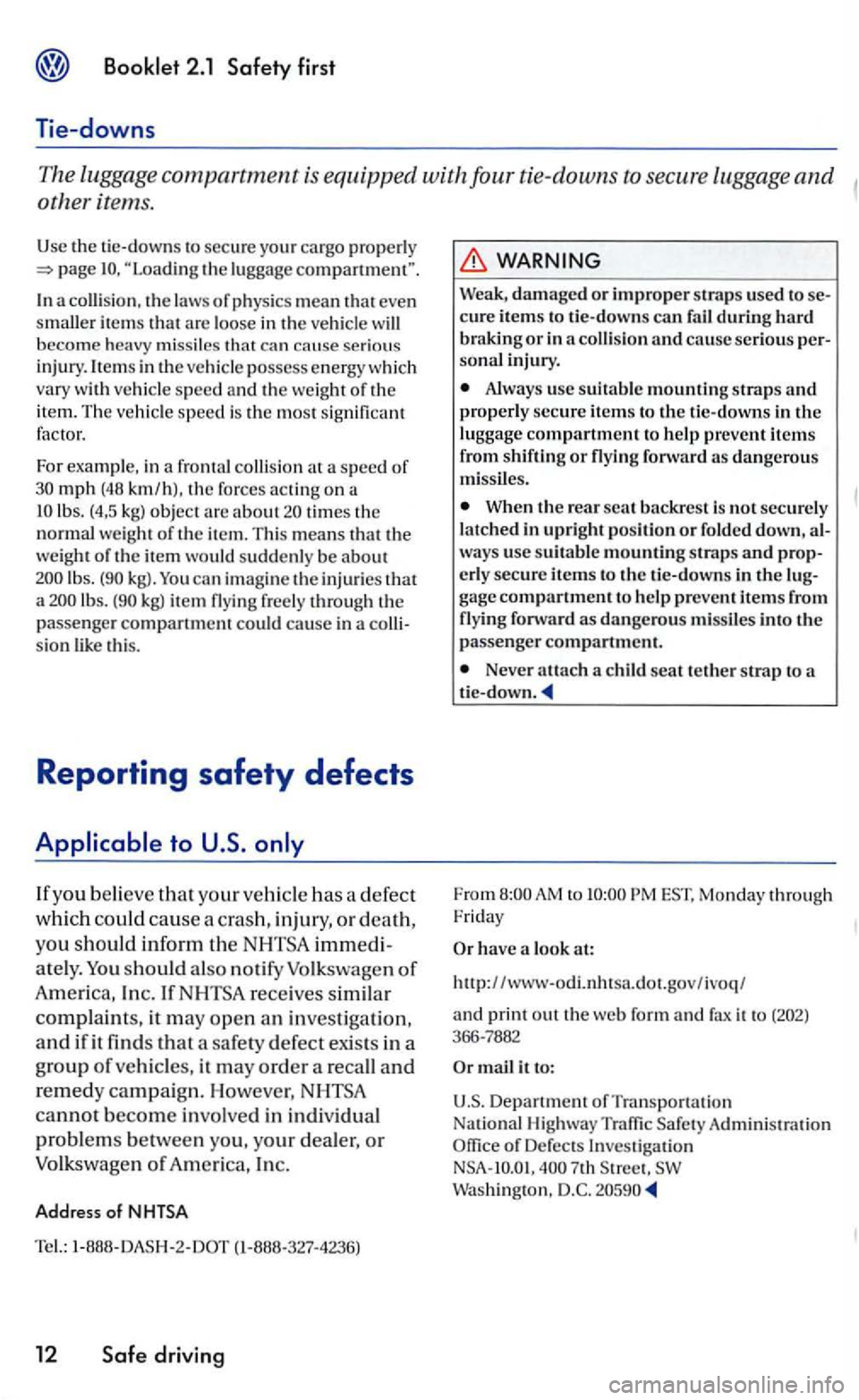
2.1 Saf ety fir s t
Tie-downs
The luggag e c
ompartment is equipped with four tie-downs to secu re luggage and
other it ems.
Use th e tie-downs to secu re you r cargo properly "Loa ding the lu ggage com part mem ".
a collisio n, th e law s of phy sics mean that even
s m aller items that are loose in the vehicle will become heavy missiles that ca n ca use serio us
i njury. h em s in the vehicle possess energ y which vary with vehicle speed and the we ight of the item . T he vehicle sp eed is th e mo st sig nifi cant factor.
For example, in a fronta l
collision at a speed of km /h), the forces acting on a times th e
n ormal weight of the item . Thi s means that the weigh t o f the it em wo uld suddenly be about lbs. kg). You can imagine the inj uries that lbs. kg) item f r ee ly through the passenger compartmem could cause in a
If yo u believe that your ve hicl e has a defec t
w hi
ch co uld ca use a c rash, injury, or death,
yo u sh ould inform the
ate ly. should also notify Volk swage n of
America, Inc. If receives similar
complaints, it may open an inves tigation ,
and if it finds that a safety defect exis ts in a
group of vehi cles, it may order a recall and
remedy campaign . H ow ever,
(1-888-327-42 36)
12 Safe driving
WARN ING
Weak, dam age d or improper strap s used to c ure item s to tie -downs can fail during hard or in a collision and cause serious sonal injury.
Alw ays use suitabl e mounting straps and properly secure item s to th e tic -downs in the luggage compartment to help prevent items from shifting or flying forward as dangerous
m issiles .
When th e re ar scat backre st is n o t securely
latched in upright posit ion or fo ld ed down,
erly secure items to the tie-downs in the g age compartment to help prevent items from
flyin g fonvard as dangerous missiles into the passenger compartment.
Never attach a child seat t eth er strap to a
From to Mo nday throug h
Frid ay
have a look at:
http://www-odi. nhtsa.dot.gov/ivoq/
and print out the web form and fax it to
m ail it to:
U
.S. Departmem of Tra nspo rtatio n Nationa l Highwa y
7th Wash ington,
Page 103 of 444
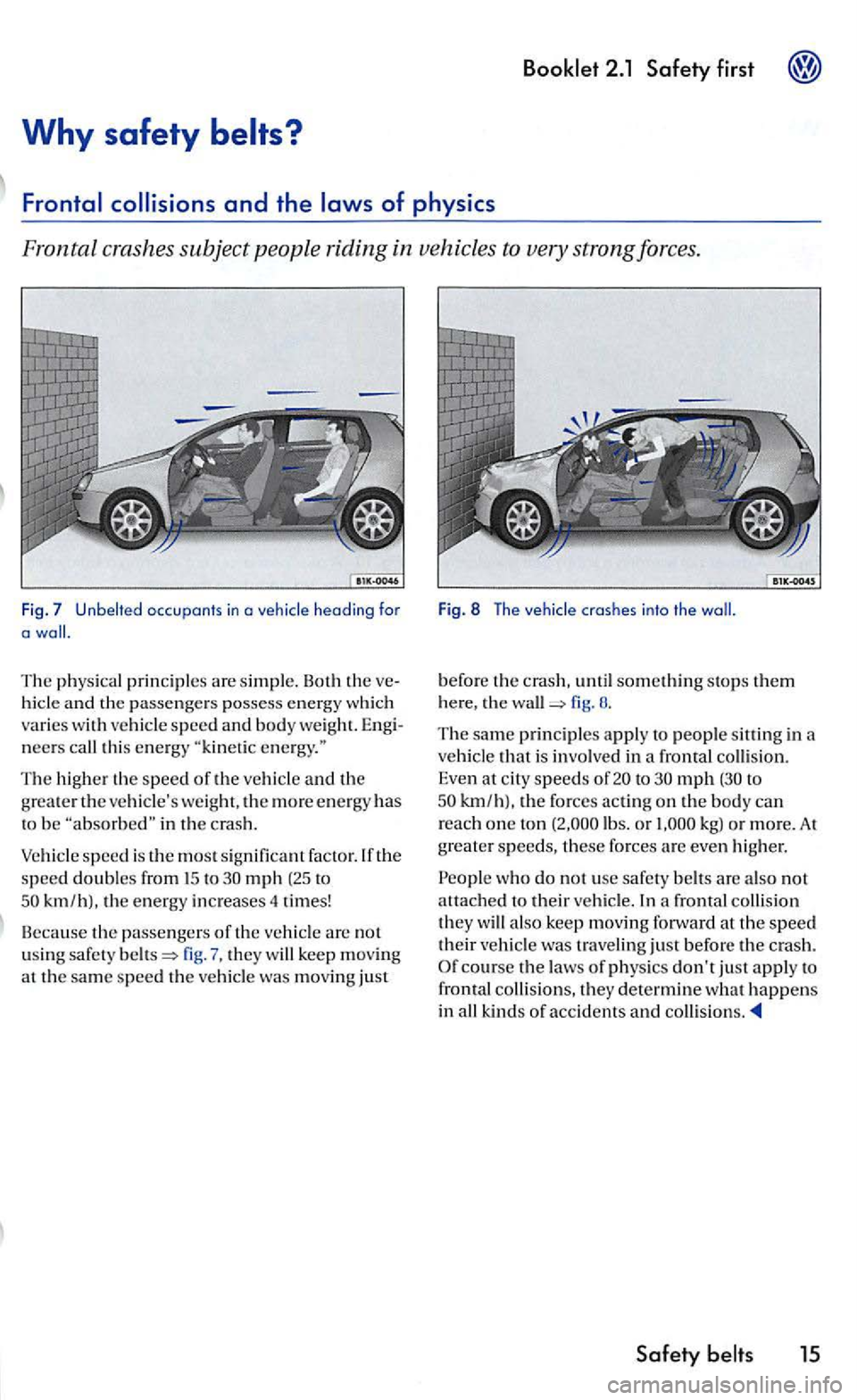
first
Why safety belts?
occupants in a
The physical prin ciples are simpl e. Both the
neers call this energy
The higher the speed of the vehicle and the grea te r th e vehicle's weight, th e more energy has to be in th e crash.
Vehicle spee d is the most s ignificant factor.lfthe speed doubles from 15 to mph (25 to km /hJ. the energy inc reases 4 times!
Because the passengers of th e veh icle are no t
using safety fig . th ey will keep moving at th e sa m e speed the ve hicl e was moving just
Fig . 8 The vehicle crashes into th e
before th e until something stops them th e wall fig. 8.
The same principles ap ply to people s itting in a
ve hicle that is in volved in a fron ta l collis io n.
Even at mph th e fo rces acting on th e body can reach one ton kg) or more. A t
greater
course the laws of phys ics don 't just apply to
frontal collisions, they determine what happens in all kinds of accidents and collisions.
Page 118 of 444
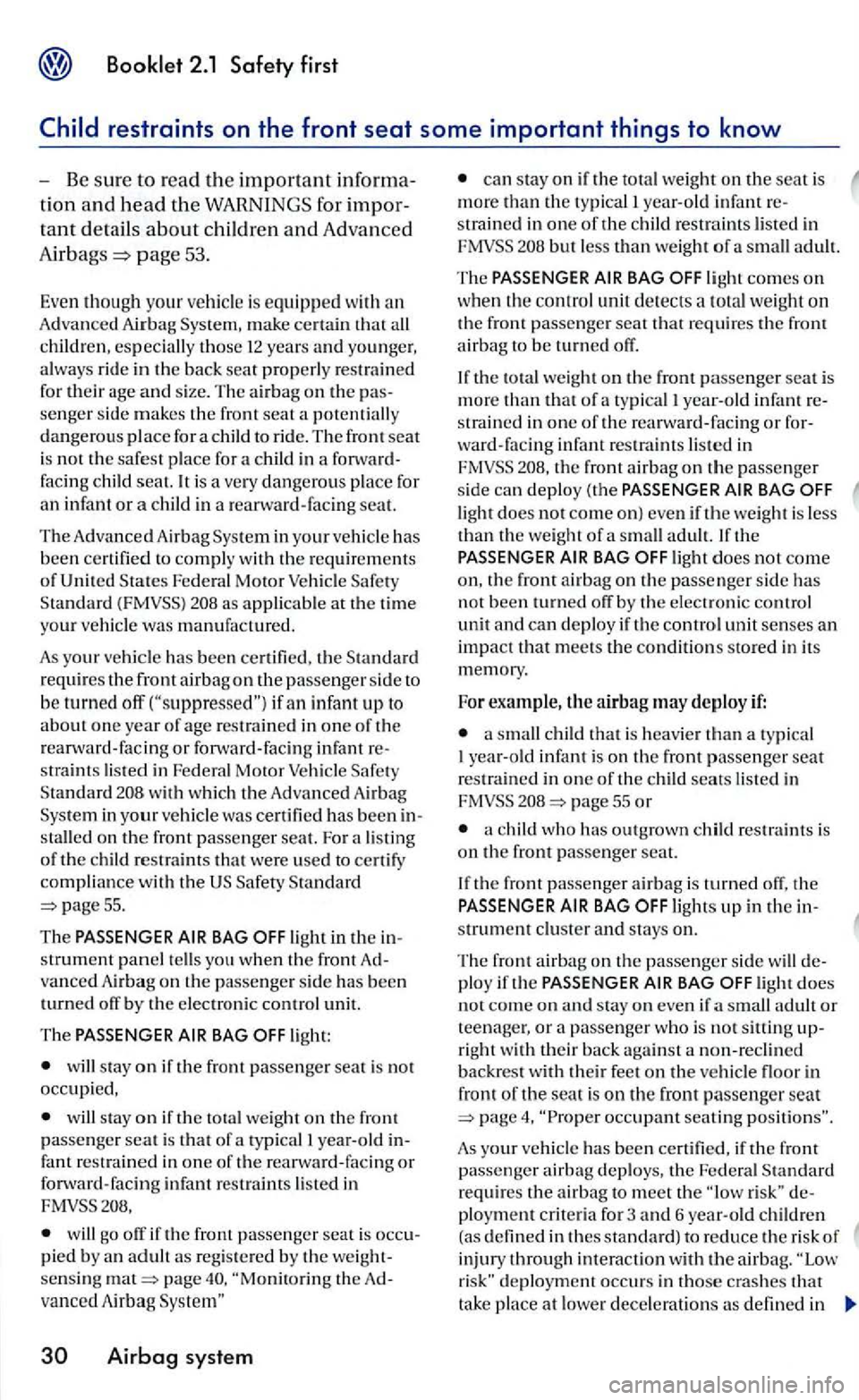
page 53.
Eve n though your vehicl e is equipped wit h an Advanced Airbag System, make certain that all childre n , especially those 12 years and younger, a lways ride in the back seat properly restrained for their
if an infant up to about one year of age restrained in on e of the rearward-fac ing or forward-facing infant re
straints lis ted in Federal Mo tor Standard 208 with which the Advanced Airbag Sys te m in your was certified has been installed on the front passenger seat. For a listing of the child restraints that were used certify compli ance with the
55.
The PASSENGER
will stay on if the front passenger seat is not occupied,
will stay o n if the tot al weight o n the front passenger seat is that of a typical year-o ld infant restrain ed in one of th e rearward-facing or forward-fa cing infant restraints listed in
w ill go off if the front passenger seat is occupied by a n adult as re gis te red by the weightsen sin g page 40,
can stay on if the weight on the seat is more than th e typical! year-o ld infant re-
strained i n one of the child restraints li sted in 208 but less than weigh t of a small
the total weigh t on the front passenger seat is more tha n that of a typica l
208, the front airbag on the passenger side can deploy (the PASSENGER
light does not come on) even if the weight is less than the weight of a small adult. I f the PASSENGER light does not come o n, th e front airbag o n the passenger side has not been turned off by th e e lectronic control unit and can deploy if the control unit senses an impact that meets the conditions stored in its
memory.
For example, the airbag may deploy if:
a small chil d that is heavie r than a typical year-old infant is on the front passenger seat restrained in one of the c hild seats liste d in 20 8 page 55 or
a child who has outgrown child restraints is on the front passenger seat.
If the front passenger airbag is turned off, the PASSENGER and sta ys on.
The front airbag on the passenger sid e w ill deplo y if the PASSENGER BAG lig ht does not come on and sta y on even if a small or teenager, or passenger who is not sitting up
right w ith their back against a non-recl in ed bac kre st with th eir feet on the in
front of the seat i s on the
deployment occurs in those crashes that ta ke place at lowe r decelera ti o ns as defined in
Page 119 of 444
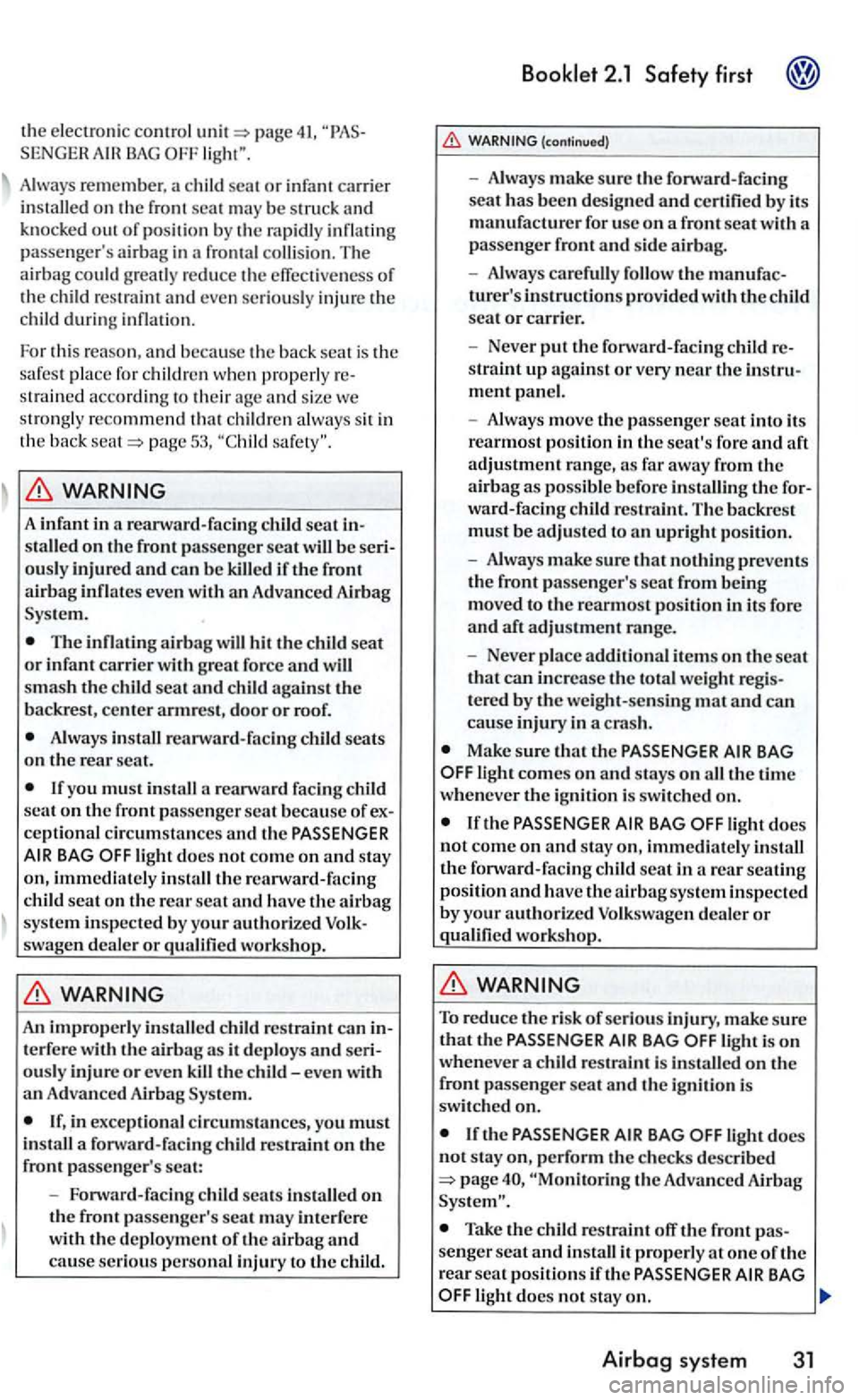
the elec tronic control page 41, SENGER
Always remember. a child seat or infa nt carrier
in stalled on th e fron t seat may the rapidly pas senger's airbag in a frontal collision. The
airbag could greatly re duce the effectiveness of the c hild restraint and even seriou sly injure th e
c hild during
stro ng ly recommend that children always sit in
th e back page 53,
infant in a seat stall ed on th e front passe nge r seat ously injured and can be killed if the front
airbag inflates eve n with an
System.
The inflating airba g will hit the child seat or infant carrier with great force and will
smas h th e c hild seat and c hild against the backrest, cent e r armre st, door or roof.
Always install r earwa rd-facing child seats on the rear scat.
If you must install a rearward facing child seat on the front passe nger scat becau se of
light docs not com e on and stay on, imme diatel y
your authorized swage n dealer or qualified workshop.
terferc with the ously inju re or even the child -eve n with
a n A irb ag
in exceptio nal circumstances, you must
in stall a fonvard-facing c hild restraint on the front passe nger's sca t:
-
Fon vard-facin g seats install ed on the front passenger's seat may interfer e
with the deplo ym ent of the air bag and cause seriou s personal injury to the child .
2.1 Safety first
turer's instructions provid ed with the c hild
sea t or carrier.
- Neve r
put the fonvard-faci ng c hild
ment panel.
- Always move the passe nge r sca t into its
rearmost pos ition in the scat's fore and aft adjustment range, as far away from the airbag as possi ble before installing ward-facing
scat that can increase the total weight te re d by the weig ht-sensing mat and ca n
ca use injury in a cras h.
Make sure that the BAG light comes on and stays on all the time w henever the igniti on i s switc hed on.
th e BAG light does not com e on and stay on , imm ediately in stall the fonv ard-facing child scat in a rea r seatin g
position and have the airba g sys tem inspec ted
by your authorized Volkswagen dealer or qualified workshop.
To reduce the ris k of se rious injury, make su re that tltc light is on whenever a child restraint is install ed on th e
front passenger scat and the ig niti on is switched on.
the d ocs not stay on, perform th e c hecks descr ibed the Advanc ed
Take the c hild restra int off the front senger seat and in stall it properly at one of the
r ear sea t position s if th e BAG light does not sta y on.
Airbag system 31
Page 123 of 444
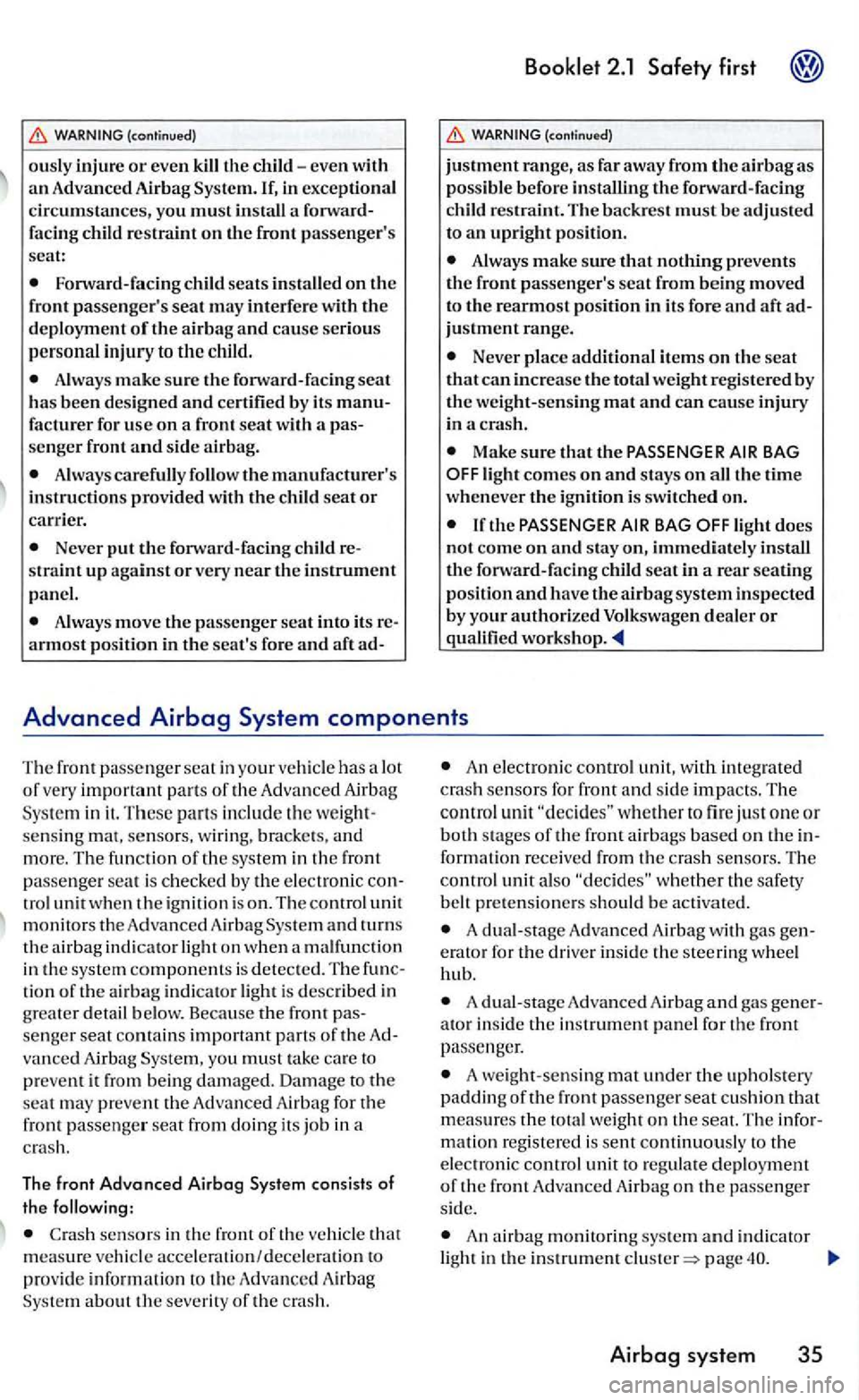
Forward-facing child seats insta lled on the front passenger's seat may interfere with the
d eployment of the airbag and cause serious
personal injury to the child.
Always make sure the fonvard-facing seat has been designed and certified by it s fa cturer for use on a front scat with a senger front and side airbag.
Alway s carefully follow the manufacturer's instructions provided with the child seat or carrier.
Never put the fonvard-facing child
Always move the passenger seat into its arrnost position in the seat's fore and aft
(cont;nued)
justment range, as far away from the airbag as poss ible before installin g the fonvard-facing
c hild restraint. The backrest must be adjusted to an upright position.
Always make sure that nothing prevents the front passenger's seat from being moved to the rearmost position in its fore and aft justment range.
Never place additional it ems on the seat that can increase the total weight registered b y the weight-sensing mat and can cause injury in a crash.
Advanced Airbag
trolunit whent h e igniti on i s on. The control unit monitors the Advanced AirbagSystem and turns
th e airbag indicato r light on w hen malfunction in the syste m components is detec te d. The tion of the a irbag indicator light is described in
g reater detail below. Because the front
vanced Airbag you must take car e to prevent it from being dam aged. Damage to the seat m ay prevent the Advanced Airb ag for th e
front passenger seat from doing its job in a
crash.
The front
Advanced Airbag System consists of the following:
Cras h sensors in the front of the ve hicl e th at measure ve hicle accelera tion /deceleratio n to
prov ide informatio n t o the Advanced Airbag
Sys tem about the severity of the cras h.
An electronic control unit, with integra ted crash sensors for fr ont and side impacts. The control u nit whethe r to fire just one or b oth stages o f the front a irbags based o n the formation received from the cra sh sensors. The control unit also w hethe r th e safety belt pretensioners should be acti va ted.
A dual -stage Ad vanced Airbag with gas
A dual-stage Adva nced Airb ag and gas
A weight-sensi ng under uphols tery
paddi ng of the front passenger seat c u shion that m eas ure s th e total weight on the seat. The matio n registered is sent continuous ly to regulate deployment of th e front Advanced Airbag on the passenger side.
An airbag monitoring system and indicator light in the in strument page
Airbag system 35